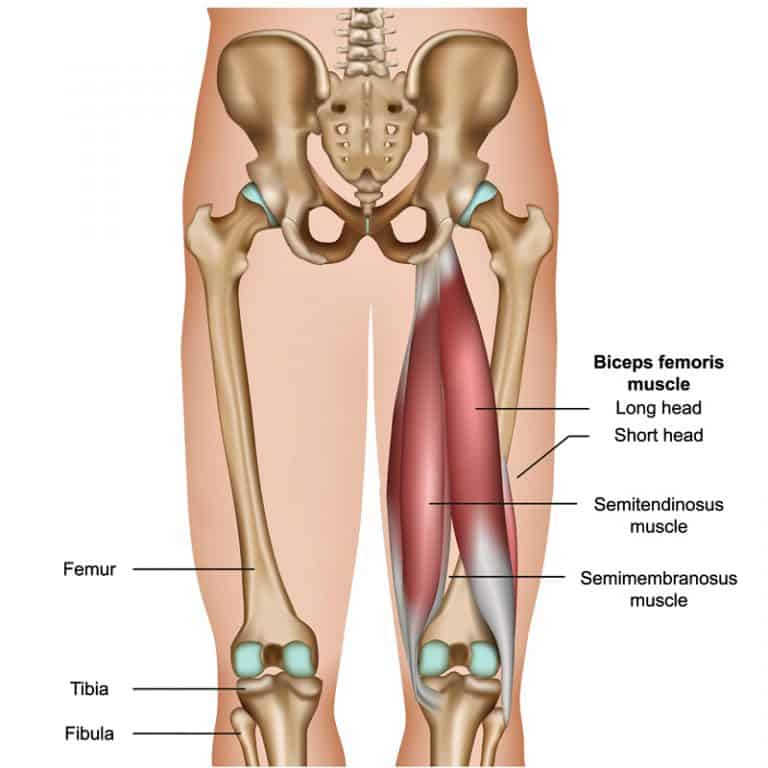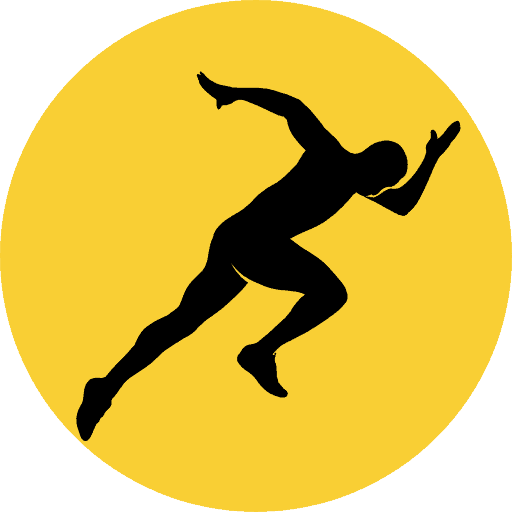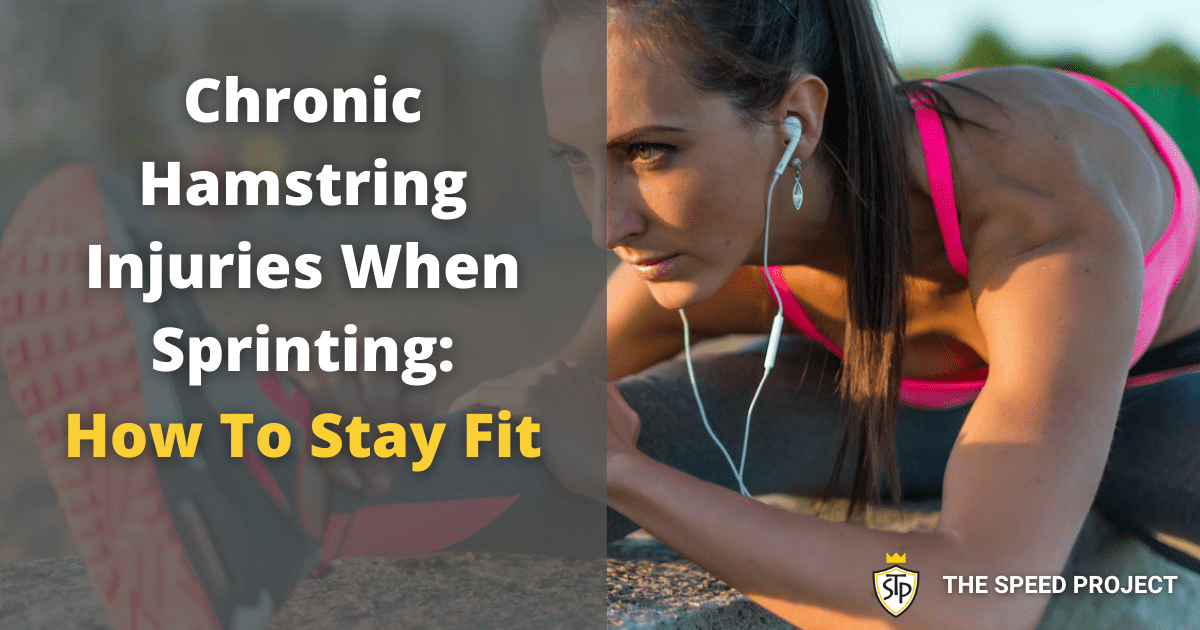Let’s face it, chronic hamstring injuries are a potential problem that continues to frustrate coaches and athletes. You can seem to do everything correctly yet the hamstrings are an area that always seems particularly vulnerable.
Hamstring strains and tears are very common in power and speed-dependent sports that require full exertion. The high-intensity nature of the activity makes the hamstring muscles more susceptible to injury. Therefore they are a recurring problem for sprinters.
Note: This article will be specifically referring to hamstring injuries when sprinting. However many of the principles applied here can be used to reduce the risk of many injuries in general.
Hamstring Anatomy
The hamstrings are actually a collective term that refers to a group of four muscles. The muscles that make up the hamstrings are the Semimembranosus (SM), the Semitendinosus (ST), the Biceps Femoris long head (BFlh) and Biceps Femoris short head(BFsh).

The four hamstring muscles are not identical and have differences in structure and function. The SM, ST and BFlh are all biarticular muscles, which means they are two jointed.
These muscles cross at the knee and the hip joint. Therefore they are involved in both knee and hip movements. Both required functions when sprinting).
This is possibly a reason for their vulnerability to injury.
Hamstring Functionality During Sprinting
Whilst sprinting, the primary function of the hamstrings is to decelerate the lower leg in the sagittal plane. During the swing phase of the stride cycle, the thigh is lowered.
The muscles within the hamstrings work eccentrically to prepare the limbs needed to support the weight of the body upon ground contact (when the foot strikes the ground).
The hamstring muscles store elastic energy. Once foot strike occurs, the hamstrings elongate across the hip and knee joints.
During the concentric contraction, the hamstrings help extend the hip. The muscles of the hamstring contain a high number of fast-twitch muscle fibres. Their fast-twitch nature means that they can produce a large amount of force.
When producing a high intrinsic force, tension is developed in the hamstrings. This, combined with the extrinsic stretch that takes place during length changes in the muscle, is why the muscle is so susceptible to injury.
Type Of Injuries
The type of injury that occurs most when performing sprints or heavy loaded activity are type 1 acute hamstring strains.
We can define an injury to the hamstring muscles as:
‘A strain or tear within the muscle fibres, the muscle and or tendon, or the point at which the tendon is attached.’
The point where the muscles are most susceptible to injury whilst sprinting is during the touchdown phase of the stride cycle. This is right before the point of foot contact with the ground.
The reason for this is due to a large amount of force that is being placed upon the muscle.
Causes of Injury
As mentioned, for sprinters, the point of injury at the hamstrings usually occurs just before ground contact of the lead leg.
Despite this, there are actually many different factors that could contribute to why these injuries occur.
Most hamstring injuries are a result of one or a combination of the following factors…
Fatigue Through Overtraining
One of the most common causes of injury is fatigue brought on by overtraining. Simply put, when the muscle is fatigued, it is more susceptible to injury as you can lose coordination of your muscles.
The muscles need to be activated to perform the required function. If one muscle is firing but another is not, then it’s more likely that an injury will occur.
Fatigue Through Schedule
Fatigue brought on by training and competition schedules needs to be considered. For example, if you have competitions scheduled 3 weeks in a row, then your training schedule needs to be adjusted.
During an event, a 100m sprinter may run in several races before making it to the final. This can put a lot of stress on the hamstrings and can fatigue the muscles very quickly.
Therefore it is important to plan your training very carefully in the build-up to competition.
Previous Injury
If you have previously injured your hamstring muscles then the chances of reinjury become higher.
Huge importance should be placed on recovering fully before attempting to train at a high intensity. Do not rush back into training or competition.
Stretching, Mobility And Flexibility
A lack of flexibility in the hamstrings and other posterior muscles of the trunk and legs are likely to lead to an injury.
You don’t want to stretch too much, but if you have poor hamstring flexibility, then I suggest you make it a priority to fix this.
It can be boring, and you may feel like skipping them. But the extra minutes saved through rushing your stretches is not worth the weeks/months out being unable to train or compete.
Hold your static stretches from 10-20 seconds.
For explosive actions, the muscles need to exert a lot of force and be able to handle the pressure. Therefore you want to be mobile and flexible, but not to the extent of a gymnast.
The types of stretching we use are static, dynamic and proprioceptive neuromuscular facilitation (PNF).
Note: PNF stretching requires the partner to place resistance upon the athlete. A coach or more experienced athletes should partner with younger/less experienced athletes for safety purposes.
Cold Weather Conditions
Cold weather conditions can be a big problem for athletes. The cold can lower muscle temperature and reduce blood flow.
When training and competing, it’s important that you layer up if training in very cold conditions. You need to keep yourself and your muscles warm! This may mean going inside or putting on another layer of clothes during your rest periods.
Poor Sprinting Technique
If you have a poor sprinting technique chances are sooner or later you will end up experiencing an injury.
Having a good technique will keep you balanced while sprinting. This will reduce the risk of injury as you’ll be able to distribute forces equally.
An issue often connected to hamstring injuries is often athletes overstriding. If an athlete has a long stride length or tries to extend their stride too much, they can overstretch the hamstrings. This can lead to straining or tearing the muscle.
What To Do If You Sustain A Hamstring Injury
After sustaining an injury it is always best to seek the advice of a medical expert. If you have any pain or loss of function within the hamstring muscles you should stop the exercise or activity immediately.
Do not try and persist as you do not know the extent of the injury and are more likely to make it worse. Better to be safe and end terminate the training session.
Signs and symptoms to look out for:
- Bruising
- Swelling
- Immediate sharp pain
- Muscle spasms
- Loss of strength
- Pain when moving
If you sustain an injury to the hamstrings then it’s important to act straight away. Performing the P.R.I.C.E. principles can help:
Protect – Protect the injured area by stopping the exercise or training and avoiding any further exercises that cause pain to the muscle.
Rest – Do not train. Don’t perform any activity that places stress or causes pain within the hamstrings.
Ice – Place ice on the hamstrings where there is pain or swelling for 10-15 minutes, every 2 hours for the first 2-3 days. This will help reduce pain and swelling. Use an ice pack sleeve or a towel to wrap around the ice. Never place the ice directly onto the skin.
Compression – A compression wrap may help reduce the swelling.
Elevation – Elevation of the muscle encourages blood flow to help reduce the swelling.
Return To Activity
One of the biggest mistakes athletes make is returning to training too soon after injury. The hamstrings need time and rehabilitation to recover fully.
I recommend not doing any intense sprinting from 6-8 weeks after the point of no pain. This gives you plenty of time to introduce and implement recovery work to strengthen the hamstrings.
It may seem like a long time but if the issue is taken care of properly then it greatly reduces the risk of the same injury occurring again.
Before beginning any speed work, you should be able to perform light runs without feeling any pain. Even mild pain can be an indicator to stop. Don’t ignore any symptoms!
Continuous treatment should be carried out during your return to training.
- Soft tissue massages
- Stretching
- Muscle strengthening
- Sport-specific movement
Note For Coaches
It’s important for coaches to be careful when it comes to the length in recovery time.
Remember, recovery times will often vary for different individuals. Also, the demands placed on the hamstrings of an athlete are much greater than that of the average person.
Note For Athletes
A good way to determine the state of recovery is to simply compare how the previously injured hamstring feels compared to the uninjured one.
Look for whether the range of motion and the strength of the muscles are the same. Also, look out for any major muscle imbalances that may have occurred.
9 Tips On How To Prevent Hamstring Injuries
If you put in a few precautionary measures then injuries become a lot less likely. Implementing injury prevention strategies doesn’t have to be difficult. Here are 9 tips on things you can do to prevent a hamstring injury:
- Don’t rush your warm-up or cool down. Complete all the exercises correctly.
- Stretch before and after training. (We mostly perform dynamic stretches during the warm-up and static stretches during the cooldown).
- Get regular deep tissue massages. If you are unable to get regular massages then purchase a foam roller and massage ball. They work great!
- Complete simultaneous eccentric and concentric exercises during your training. Do this so that the hamstrings can cope with high forces during ground contact.
- Wear appropriate clothing for the weather conditions. Keep warm in cold conditions. Thermal clothing is a great option.
- Complete dynamic exercises as part of your warm-up.
- Consider the muscles above and below the hamstrings when strength training. Pay special attention to your hip flexors, glutes and calves.
- Address both knee flexion and hip extension when strengthening.
- Correct any muscle imbalances.

